A collection of canines
More dogs than you can throw a stick at
by Stephen Inniss
Although some of the wild canids
(wolves, foxes,
and their kin) have been
described briefly in the Monster Manual,
others which might be of interest to AD&D®
game adventurers are not mentioned. As for
the three that have already been covered,
the entries on them might be fleshed out to
the benefit of a campaign. The same might
be said of canid-like carnivores such as
hyenas, which are covered in the latter
portion of this text. Player characters will
frequently encounter these animals, if only
through the agency of conjuring and summoning
spells, and some characters (particularly
druids and magic-users) will take the
forms of these animals.
Described below are several canids and
canid-like carnivores, including those already
detailed in the Monster Manual.
In
the latter cases, new material has been
added, and a few changes are suggested.
These changes are based on available information
about these animals, with the assumption
that those found in the AD&D
game world are much like their equivalents
in the real world. Reasons for some specific
alterations are given at the end of the descriptions.
Canids, wild
Canids are very successful predators and
are common in their native haunts. The
number encountered can be highly variable,
except in the case of solitary species such as
the fox. In some cases two ranges are shown
for number appearing, one for times and
places in which prey is small or scarce (the
lower number) and one for those in which
prey is large and abundant (the larger number).
Wolves, for instance, are found in
greater numbers during the winter, when
they hunt deer and moose, than in the
summer, when they hunt mice and rabbits.
As indicated in the Monster Manual,
these
ranges are to be used as guidelines, not
rules. For instance, several otherwise separate
groups of canids might gather and
mingle where food is superabundant:
wolves scavenging at the site of a battle,
hunting dogs where large herds of animals
are on the move, or foxes in a mouse-rich
meadow. It is suggested that 5% of encounters
with canids should be in the vicinity
of a large carcass. In such a case, there is
a 25% chance that 1-2 other groups of
canids (chosen at random from the appropriate
types) will also be present, and a
25% chance (checked separately) that another
carnivore or group of carnivores is in
attendance. The largest, most numerous,
and hungriest animals will have taken possession
of the kill, and the others will dispute
this or wait for an opportunity to steal
or scavenge.
Canids are all at least as speedy as humans,
though none of them are quite so fast
as a horse or deer. It is noteworthy that
canids are not slowed as much by undergrowth
or rough ground as humans are, so
that even the stubby-legged bushdog can be
a good deal faster than a man under certain
conditions. The smaller canids (those
weighing less than 40 pounds) swim at 6",
while the larger ones swim at 9". Most are
handicapped by the fact that they must keep
their heads above water, since unlike humans
they cannot submerge themselves
without getting water in their nostrils. An
exception to this is the bushdog, which can
immerse itself without difficulty and can
swim at 9") despite its small size. Only
dholes and bushdogs will willingly enter the
water. With the exception of foxes, no canids
can climb.
The smallest canids are given two damage
ranges for the bite, the larger amount
being applicable to creatures less than three
times their weight and the larger amount
being applicable to creatures of more than
three times their weight. This reflects the
fact that these animals are deadly to their
usual prey, but less so when larger animals
are concerned. Note that some canids of
approximately the same size are given
different amounts of bite damage. This is a
reflection of differences in anatomy and
behavior.
The smallest canids are given two damage
ranges for the bite, the larger amount
being applicable to creatures less than three
times their weight and the larger amount
being applicable to creatures of more than
three times their weight. This reflects the
fact that these animals are deadly to their
usual prey, but less so when larger animals
are concerned. Note that some canids of
approximately the same size are given
different amounts of bite damage. This is a
reflection of differences in anatomy and
behavior.
Canids encountered in the lair during the
season of greatest abundance (spring, or the
beginning of the rains) will always include
one male and one female, even in solitary
species, and 2-8 pups. All of the adults help
care for and guard these pups, which are
usually kept in a cave or burrow. Among
social canids, the pups will typically be the
offspring of the dominant female (the one
with the largest hit-point total) and her
chosen mate (usually the dominant male).
Pups have no effective attack. There is a
30% chance that they will be young enough
to be tameable.
Though canids of a suitable age can be
tamed, they cannot be made over into
domestic dogs. They will certainly be affectionate
if they are well treated, but taming
and training are 2 very different things.
Solitary canids (coyotes, dingoes, and
jackals) are only a little easier to handle.
Like solitary canids, semi-social ones do not
understand dominance and submission, and
may retaliate if they are disciplined. As
adults they may wander away from their
handlers, just as in the wild they eventually
leave their parents. The social canids
(bushdogs, dholes, feral dogs, hunting dogs,
wolves, and dire wolves) can be trained as
well as tamed. With the exception of feral
dogs, though, they will seem aloof and
indifferent by comparison with domestic
dogs, and since they are less dependent on
approval they are more difficult to teach. At
least, though, they can be persuaded to
accept their handlers and perhaps a few
others as pack members, preferably senior
pack members. In any case, a tamed canid
will always be suspicious of new people and
new things, and will not adapt well to civilized
life. It may seem unpredictable because
it does not always understand human
SIGNALS and because wild canids are often
difficult to "read." These misunderstandings
may have tragic results.
Some of the abovementioned difficulties
can be mitigated if a spell such as animal
friendship is used, or if the handler makes
frequent use of speak with animals, but
charm spells will be ineffective since the
problem lies not with how well the animal
loves its handler but how well it expresses
that emotion. Feral dogs do not present the
above problems, since they retain something
of their domestic ancestors' instincts,
although they too may seem unruly by
comparison with true domestic dogs.
Coyotes, dingoes, wolves, and jackals are
all fertile with domestic or feral dogs and
with each other, though they do not normally
interbreed. The offspring themselves
fertile, are intermediate in most charactieristics,
though from a human point of view
crosses of domestic with wild canids look
and act "wild" and present the training
problems described above, being difficult to
train and seemingly unpredictable. A dog-wolf
cross, for instance, inherits the wolfs
aloofness and hostility to strangerss,
and this, along with its larger size and powerful
jaws, might suggest that it would be a
good guard dog. However, it shows a wolfs
reluctance to bark, and it may show wolflike
caution and simply avoid an intruder rather
than risk an attack.
Canids of all sorts have keen senses of
smell and hearing. In good light, a canid?s
sense of sight is less exceptional, since canids
do not perceive colors and haven?t the
sharpness of vision that humans have.
However, a canid can see about as well by
moonlight as by daylight, and can see as
well on a moonless night as a human would
under a full bright moon. A canid?s hearing
allows it a 20% bonus to its chances of
detecting hidden or invisible creatures,
where applicable. This bonus may be
halved or doubled according to circumstances.
A similar 20% bonus is granted
because of the canid?s keen sense of smell,
as appropriate. This bonus too may be
halved or doubled as circumstances warrant.
An alert wolf, for instance, can detect
a human for quite some distance downwind,
and canids can even distinguish
different individuals of the same species. A
canid's nose also allows it to track as an
onyx dog
(DMG, page 144).
Canids are opportunists, and will eat
practically anything: fresh meat, carrion,
fruit, insects, and even some roots and
grasses, including what humans would
regard as garbage. Dholes, hunting dogs,
and bushdogs are more exclusively predacious
than the others, while foxes are best
described as omnivores with a preference
for meat. The others fall somewhere in
between, with the larger and more social
sorts showing a greater preference for hunting.
Even the largest canid is cautious, and
will seldom attack an animal of its own size
or larger that fights back. A wound can be
fatal, even for an individual that is supported
by the rest of the pack; the animal
may well starve before it recovers, even
living on "charity." This doesn't mean that
hunting canids will leave humans and their
domestic animals in peace, however. They
may test them to see if they are able to run
away or defend themselves, and if they
uncover weakness they will exploit it. However,
humans (and, in an AD&D game
world, human-like creatures) are not on any
canid's "preferred" list. They are too likely
to have nasty surprises on hand, such as
swords and spears, and after centuries of
association canids know this instinctively.
Unless they are starving and desperate, they
will avoid humans entirely.
Each canid has a distinct odor, which
may be detectable to the human nose (foxes
can be quite rank). Whether or not humans
detect and approve of these odors, other
canids can detect them, and they almost
universally disapprove. Treat this as "hate"
on any interspecies reaction roll. Domestic
and feral dogs and dingoes are mutally
acceptable, however, as any canid which has
been raised with the smell in question won?t
be bothered by it.
The characteristics of the different kinds
of canids are as follows:
BUSHDOG
.

.
FREQUENCY: Common
NO. APPEARING: 2-12
ARMOR CLASS: 7
MOVE: 12"
HIT DICE: 1/4
% IN LAIR: 5%
TREASURE TYPE: Nil
NO. OF ATTACKS: 1
DAMAGE/ATTACK: 1/1-2
SPECIAL ATTACKS: Nil
SPECIAL DEFENSES: Nil
MAGIC RESISTANCE: Standard
INTELLIGENCE: Semi-
ALIGNMENT: Neutral
SIZE: S (15 lbs.)
PSIONIC ABILITY: Nil
LEVEL/X.P. VALUE: I / 5 + 1/hp
Bushdog: A bushdog is a small brownish
canid of robust build, covered with coarse,
sparse hair. It has a short, broad skull,
powerful jaws, short legs, small ears, and a
short tail, and looks somewhat like a heavily
built dachshund, or a cross between an otter
and a small dog. With their low-slung
bodies and webbed feet, bushdogs are well
suited to the heavy undergrowth and abundant
water of their native haunts. They live
in small packs and communicate using
various whistles, clicks, chirps, and squeals.
When excited, they give voice to highpitched,
metallic barks. Bushdogs regard
nearly anything of suitable size as prey, and
will pursue large water rodents, small deer,
and birds up to the size of a rhea as well as
lesser game. Young bushdogs are not difficult
to tame and train. Their expressive
faces make their moods as easy to read as
those of dogs and wolves, making the task
an easy one. Tame bushdogs are affectionate
and gentle as they are homely. Bushdogs
are tropical, living in the forest or near
water and away from settled areas.
COYOTE
Coyote (Lesser god)
.
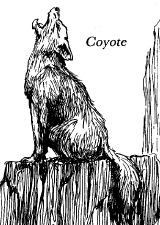
.
FREQUENCY: Common
NO. APPEARING: 1-2/2-8
ARMOR CLASS: 7
MOVE: 18"
HIT DICE: 1-1
% IN LAIR: 5%
TREASURE TYPE: Nil
NO. OF ATTACKS: 1
DAMAGE/ATTACK: 1-3
SPECIAL ATTACKS: Nil
SPECIAL DEFENSES: Nil
MAGIC RESISTANCE: Standard
INTELLIGENCE: Semi-
ALIGNMENT: Neutral
SIZE: S (30 lbs.)
PSIONIC ABILITY: Nil
LEVEL/X.P. VALUE: I / 10 + 1/hp
Coyote: This is a versatile, mid-sized
predator, able to take prey as large as sheep
or goats, although coyotes generally restrict
themselves to less difficult foods, such as
mice and berries. The typical coyote is
greyish, with long fur and long legs. Coyotes
are wary and difficult to catch; they are
less odorous than foxes and therefore more
difficult to track, and over long distances
they can outpace the fastest coursing
hounds. Semi-social, coyotes can be tamed
but not trained. They may be found in any
climate from subarctic to subtropical and in
any sort of terrain, even invading the
mountainous parts of the tropics. They
thrive in both settled and domestic areas.
DHOLE
.
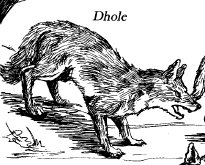
.
FREQUENCY: Common
NO. APPEARING: 4-16
ARMOR CLASS: 7
MOVE: 15"
HIT DICE: 1+1
% IN LAIR: 5%
TREASURE TYPE: Nil
NO. OF ATTACKS: 1
DAMAGE/ATTACK: 1-4
SPECIAL ATTACKS: Nil
SPECIAL DEFENSES: Nil
MAGIC RESISTANCE: Standard
INTELLIGENCE: Semi-
ALIGNMENT: Neutral
SIZE: S (40 lbs.)
PSIONIC ABILITY: Nil
LEVEL/X.P. VALUE: I / 20 + 2/hp
Dhole: The dhole, or red dog, resembles
a domestic mongrel at first glance, but it
carries its bushy tail low and has reddish
fur, short legs, and a short muzzle that has a
unique profile: the line from skulltop to
nosetip is convex rather than concave.
Dholes hunt in large, highly cooperative
packs, and they chatter when they are excited
(they seldom bark). Aggressive and
bold, they will attack even the largest herbivores,
though they prefer deer-sized
game. They have been known to drive away
or kill competing predators, including tigers.
Dholes trot tirelessly after their chosen
prey, following it until it weakens and is
suddenly vulnerable to a sudden coordinated
rush. What they lack in sprinting
speed, dholes make up for in endurance.
Unlike other canids they are fond of water;
it is difficult to escape them. Dholes hunt by
day, or on moonlit nights. Dholes show little
fear of humans, but are not known to attack
them either. They can be tamed if captured
when young, but are perhaps more difficult
to handle than some other social canids
might be because of their relatively inexpressive
faces. Dholes live in both the forest
and the steppe in temperate to subarctic
climes. They survive in both settled and
wilderness areas.
DINGO
.
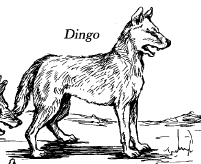
.
FREQUENCY: Common
NO. APPEARING: 1-2/2-8
ARMOR CLASS: 7
MOVE: 15"
HIT DICE: 1-1
% IN LAIR: 5%
TREASURE TYPE: Nil
NO. OF ATTACKS: 1
DAMAGE/ATTACK: 1-3
SPECIAL ATTACKS: Nil
SPECIAL DEFENSES: Nil
MAGIC RESISTANCE: Standard
INTELLIGENCE: Semi-
ALIGNMENT: Neutral
SIZE: S (35 lbs.)
PSIONIC ABILITY: Nil
LEVEL/X.P. VALUE: I / 10 + 1/hp
Dingo: Though they are like coyotes in
size, build, and habits, dingoes are descended
from or closely related to domestic
dogs. Evidence of domestic ancestry is to be
found in dingo coat colors and patterns,
which (in addition to the nondescript tawny
color typical of wild dogs) range through
black, red, white, yellow, brown, and piebald,
though none of these is as common as
the "wild" type. Like coyotes, dingoes may
be found in any sort of terrain, but they
range from tropical to temperate climes
rather than from subtropical to subarctic.
They will not occur together with coyotes.
Dingoes are semi-social. They can be tamed
but not trained.
FERAL DOG
.
.
.
FREQUENCY: Common
NO. APPEARING: 1
ARMOR CLASS: 7
MOVE: 18"
HIT DICE: 1
% IN LAIR: 5%
TREASURE TYPE: Nil
NO. OF ATTACKS: 1
DAMAGE/ATTACK: 1-4
SPECIAL ATTACKS: Nil
SPECIAL DEFENSES: Nil
MAGIC RESISTANCE: Standard
INTELLIGENCE: Semi-
ALIGNMENT: Neutral
SIZE: S (45 lbs.)
PSIONIC ABILITY: Nil
LEVEL/X.P. VALUE: I / 10 + 1/hp
Feral Dog: This type is not truly a wild
canid. Feral dogs are domestic dogs that
have spent a generation or more away from
human interference. Natural selection tends
to produce an animal midway in size between
coyote and wolf, and features such as
droopy ears, odd coloration, gigantism,
dwarfism, and so on become less common
with each generation. Feral dogs do not
occur together with truly wild canids of the
same size, since they can't compete, especially
where seasons are marked. Like domestic
dogs, feral dogs may bear young at
any time of the year, including such inappropriate
times as the middle of the winter
or the height of the flood season. Feral dogs
will be found in most climes and sorts of
terrain, but only within 50 miles of human
settlements. They can be tamed if captured
young, and are in effect domestic dogs.
FOX
.
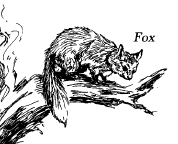
.
FREQUENCY: Common
NO. APPEARING: <?>
ARMOR CLASS:
MOVE: 18"
HIT DICE: 1/4
% IN LAIR: 5%
TREASURE TYPE: Nil
NO. OF ATTACKS: <?>
DAMAGE/ATTACK: 1-2/1
SPECIAL ATTACKS: Nil
SPECIAL DEFENSES: Nil
MAGIC RESISTANCE: Standard
INTELLIGENCE: Semi-
ALIGNMENT: Neutral
SIZE: S (10 lbs.)
PSIONIC ABILITY: Nil
LEVEL/X.P. VALUE: I / 5 + 1/hp
Fox: Foxes and foxlike canids of various
sorts are found everywhere, from the high
arctic, to the deep tropical rain
forest. Except
when rearing their pups, they are
solitary, and they are generally nocturnal.
They catch game of pheasant size or less,
and feed on whatever else is available. Most
kinds are unobtrusive and wily enough to
survive in settled areas despite organized
persecution. Being asocial creatures, foxes
can be tamed but not trained.
HUNTING DOG
.
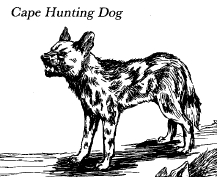
.
FREQUENCY: Common
NO. APPEARING: 4-24
ARMOR CLASS: 7
MOVE: 21"
HIT DICE: 2
% IN LAIR: 5%
TREASURE TYPE: Nil
NO. OF ATTACKS: 1
DAMAGE/ATTACK: 2-5
SPECIAL ATTACKS: Nil
SPECIAL DEFENSES: Nil
MAGIC RESISTANCE: Standard
INTELLIGENCE: Semi-
ALIGNMENT: Neutral
SIZE: S (60 lbs.)
PSIONIC ABILITY: Nil
LEVEL/X.P. VALUE: I / 20 + 2/hp
Hunting Dog: Also called the African
hunting dog or Cape hunting dog, this
canid is not closely related to the others. It
resembles a big domestic dog with long legs,
an outsize head, powerful jaws, and large,
rounded ears. The short fur is sparse, and
the black skin beneath it can be seen in
places. Hunting dogs sport a peculiar harlequin
pattern: asymmetrical white blotches,
rimmed with black, on a yellowish background.
The tip of the tail is always white,
and the face and muzzle black. Hunting
dogs have a strong, musky odor. They are
efficient hunters, and can bring down anything
smaller than an elephant or a hippopotamus,
hunting in coordinated groups
near sunrise or sunset. They chatter when
excited, and make a strange, bell-like sound
in the chase. Members of the pack are very
close, and it is surprising that these canids
are not more often tamed. Their inexpressive
faces and strong odor may have something
to do with this. They can be tamed
and trained for use as coursing hounds,
though. Hunting dogs seldom attack humans,
but will take domestic animals. They
are native to open tropical country.
JACKAL
.
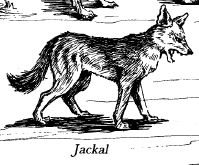
.
FREQUENCY: Common
NO. APPEARING: 1-2/2-8
ARMOR CLASS: 7
MOVE: 18"
HIT DICE: 1/2
% IN LAIR: 5%
TREASURE TYPE: Nil
NO. OF ATTACKS: 1
DAMAGE/ATTACK: 1-2
SPECIAL ATTACKS: Nil
SPECIAL DEFENSES: Nil
MAGIC RESISTANCE: Standard
INTELLIGENCE: Semi-
ALIGNMENT: Neutral
SIZE: S (20 lbs.)
PSIONIC ABILITY: Nil
LEVEL/X.P. VALUE: I / 5 +1/hp
Jackal: Jackals (there are several species)
are like coyotes in appearance and behavior,
though they are smaller. They catch game
up to the size of a gazelle or lamb but generally
eat smaller animals or scavenge,
hunting cooperatively only on occasion.
They are semi-social, like coyotes. Jackals
are found in warm temperate or tropical
climates in any sort of terrain except heavy
forest.
WOLF
.
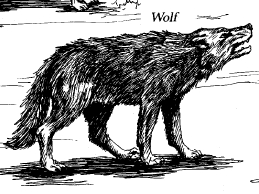
.
FREQUENCY: Common
NO. APPEARING: 1-2/2-20
ARMOR CLASS: 7
MOVE: 18"
HIT DICE: 2+2
% IN LAIR: 5%
TREASURE TYPE: Nil
NO. OF ATTACKS: 1
DAMAGE/ATTACK: 2-5
SPECIAL ATTACKS: Nil
SPECIAL DEFENSES: Nil
MAGIC RESISTANCE: Standard
INTELLIGENCE: Semi-
ALIGNMENT: Neutral
SIZE: M (90 lbs.)
PSIONIC ABILITY: Nil
LEVEL/X.P. VALUE: II / 35 + 3/hp
Wolf: Wolves are the largest modern
canids. They vary in appearance from place
to place, both in size and in color. Wolves
vary from white through greys, browns, and
red-browns to black. The larger races tend
to specialize in larger prey, but any sort will
take prey of mouse-size to moose-size.
As
with other canids, wolves (with the exception
of rabid individuals) usually leave
humans alone, though they are less circumspect
when it comes to domestic animals.
They may pick up scraps or stray animals.
During time of war, wolf populations tend
to grow, for wolves will not pass up carrion.
Since they are closely akin to domestic dogs
and they are social carnivores, wolves are
perhaps the easiest to tame and train of the
wild canids. However, they need to be kept
under strict supervision, especially when
they reach maturity at two years of age. At
that time they may try to take over leadership
in their adoptive "pack." Wolves are
found in arctic to subtropical climates, in
any sort of climate but the driest desert. In
settled areas, wolves will be rare or nonexistent.
In arctic and subarctic climates,
wolves may grow quite large: every 5th
individual will have 3_# HD and bite
for 2-7 points of damage.
WOLF, DIRE
.
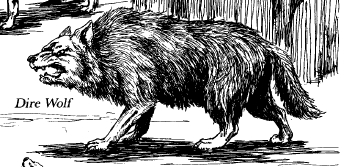
.
FREQUENCY: Common
NO. APPEARING: 3-12
ARMOR CLASS: 7
MOVE: 15"
HIT DICE: 3+3
% IN LAIR: 5%
TREASURE TYPE: Nil
NO. OF ATTACKS: 1
DAMAGE/ATTACK: 2-8
SPECIAL ATTACKS: Nil
SPECIAL DEFENSES: Nil
MAGIC RESISTANCE: Standard
INTELLIGENCE: Semi-
ALIGNMENT: Neutral
SIZE: M (150 lbs.)
PSIONIC ABILITY: Nil
LEVEL/X.P. VALUE: III / 60 +4/hp
Wolf, dire: Dire wolves are wolflike
canids from the Pleistocene epoch, and in
such settings they are quite common. They
resemble wolves in most aspects, but prey
on larger animals and are more partial to
carrion. The dire wolf looks much like an
ordinary wolf, but is more heavily built, has
proportionately shorter legs, and has larger
teeth and more powerful jaws. A dire wolf is
less intelligent than an ordinary wolf,
though still within the semi-intelligent
range. Dire wolves can be tamed and
trained, but the handler is in grave danger
should he make a miscalculation. Dire
wolves are found in the same sorts of environments
that wolves are, wherever large
prey species are available.
Prehistoric canids
Canids of the Pleistocene epoch will be
of
modern type, even to the particular species,
with the addition of the dire wolf. Similar
types will be present in Pliocene and Miocene
settings, but they will include hyenalike
forms (use the figures for hyenas given
below). Canids and canidlike predators
from earlier in the Age of Mammals will
be
3" slower, and of animal intelligence rather
than semi-intelligent. The canids have no
close analogues from earlier eras.
Hyenas
Although hyenas are more closely related
to cats than they are to canids, they
parallel
the canids in a number of ways. With the
few exceptions mentioned here, the earlier
general remarks concerning canids apply to
hyenas as well.
Like canids, hyenas are runners and
attack their prey by biting; this is related to
their somewhat similar appearance. However,
hyenas have relatively large forequarters
and small hindquarters, so that the
back slopes downward from shoulders to
hips. Hyenas typically have less elegant
pelts than canids do; their fur is coarse and
unkempt, though hyenas keep themselves as
well groomed as any canids. Hyenas also
differ from canids in that they are better
adapted to scavenging the remains of large
animals, though they are by no means poor
hunters. Hyenas have powerful jaws, and
teeth specially adapted to crushing bones,
not to mention a robust digestive system.
They can finish off not just the meat and
internal organs of a kill, but the hide and
bones as well. Even the most predatory
hyenas seldom pass up a free (effortless)
meal, and some villages depend on hyenas
to clean up refuse. Male hyenas are no
larger than females, contrary to the situation
among canids. In fact, female spotted
or cave hyenas are larger than the males.
Unlike canids, hyenas do not cooperate in
caring for their young. Raising the pups is
the sole responsibility of the female that
gave birth to them, and other hyenas may
eat these pups if they are undefended. As
with canids, the lair is typically a cave or
burrow, but the further reaches of the lair
are extended by the pups themselves among
the hyenas, and adult hyenas cannot reach
them. Among social hyenas, several females
may keep their pups in the same den. Each
female typically has 1-2 pups, and as with
canids there is a 30% chance that the pups
in any single litter encountered will be
young enough to be tameable.
CAVE HYENA
.
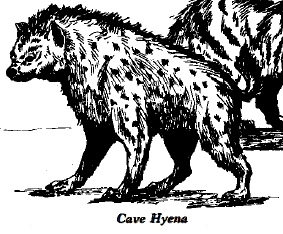
.
FREQUENCY: Common
NO. APPEARING: 2-12
ARMOR CLASS: 7
MOVE: 15"
HIT DICE: 4
% IN LAIR: 5%
TREASURE TYPE: Nil
NO. OF ATTACKS: 1
DAMAGE/ATTACK: 2-8
SPECIAL ATTACKS: Nil
SPECIAL DEFENSES: Nil
MAGIC RESISTANCE: Standard
INTELLIGENCE: Semi-
SIZE: M (200 lbs.)
PSIONIC ABILITY: Nil
LEVEL/XP. VALUE: III / 60 + 4/hp
Cave Hyena: The cave hyena is a large
variety of spotted hyena from the temperate
plains and the steppes of the Pleistocene.
It
is of the same species as the spotted hyena,
and is like it in all but size.
SPOTTED HYENA
.
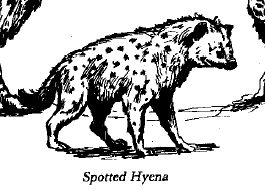
.
FREQUENCY: Common
NO. APPEARING: 2-12
ARMOR CLASS: 7
MOVE: 15"
HIT DICE: 3
% IN LAIR: 5%
TREASURE TYPE: Nil
NO. OF ATTACKS: 1
DAMAGE/ATTACK: 2-7
SPECIAL ATTACKS: Nil
SPECIAL DEFENSES: Nil
MAGIC RESISTANCE: Standard
INTELLIGENCE: Semi-
SIZE: M (140 lbs.)
PSIONIC ABILITY: Nil
LEVEL/XP. VALUE: II / 35 + 3/hp
Spotted Hyena: Spotted hyenas are dirty
orange in color, with small black spots. The
spotted hyena has a large repertoire of calls,
including the famous "laugh," which really
does sound like it ought to be coming out of
a lunatic asylum in a third-rate movie. This
laugh brings other scavengers and predators
on the run, for it means the hyenas have
made a kill. Swift runners, spotted hyenas
hunt cooperatively, and will attack anything
that doesn't put up too much of a light.
Where they depend on refuse, spotted hyenas
may start in on the human population
if
the supply of garbage falls off. These hyenas
can be tamed and used as hunting beasts if
they are caught when young. They inhabit
open country in tropical climates, in settled
and wilderness areas.
SHORT-FACED HYENA
.
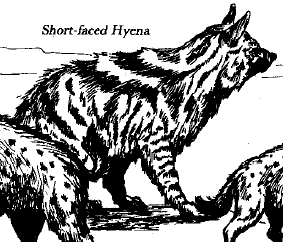
.
FREQUENCY: Common
NO. APPEARING: 1
ARMOR CLASS: 7
MOVE: 15"
HIT DICE: 5
% IN LAIR: 5%
TREASURE TYPE: Nil
NO. OF ATTACKS: 1
DAMAGE/ATTACK: 2-12
SPECIAL ATTACKS: Nil
SPECIAL DEFENSES: Nil
MAGIC RESISTANCE: Standard
INTELLIGENCE: Semi-
SIZE: L (300 lbs.)
PSIONIC ABILITY: Nil
LEVEL/XP. VALUE: III / 90 + 5/hp
Short-faced Hyena: The short-faced
hyena is a lion-sized relative of the striped
hyena from the Pleistocene.
Its habits are
those of its smaller cousin, though it can
tackle larger game. It lives in temperate
climates.
STRIPED HYENA
.
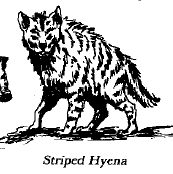
.
FREQUENCY: Common
NO. APPEARING: 1
ARMOR CLASS: 7
MOVE: 15"
HIT DICE: 2
% IN LAIR: 5%
TREASURE TYPE: Nil
NO. OF ATTACKS: 1
DAMAGE/ATTACK: 2-12
SPECIAL ATTACKS: Nil
SPECIAL DEFENSES: Nil
MAGIC RESISTANCE: Standard
INTELLIGENCE: Semi-
SIZE: L (300 lbs.)
PSIONIC ABILITY: Nil
LEVEL/XP. VALUE: III / 90 + 5/hp
Striped Hyena: This hyena (and its
relative the brown hyena, which is essentially
the same in size and habits) conforms
best to the hyena stereotype. It seldom
attacks something larger than itself (goats
and small humanoids are near the upper
limit), and shows little or no social behavior.
Striped hyenas eat human refuse, and will
also raid crops of melons, dates, grapes, or
other sweet fruits. A striped hyena is greyish,
with vertical stripes on its sides and a
crest of longer hair running down the back.
Its ears are larger and more pointed than
those of the spotted hyena. Brown hyenas
are essentially the same, except that they
are (as the name bears out) brown. Striped
hyenas can be tamed if they are captured as
juveniles, though they may be rather shy.
Striped hyenas live in open country in
tropical and subtropical regions.
Prehistoric hyenas
In Pleistocene settings the modern varieties
of hyenas will be present, along with
the larger sorts mentioned above. Also
present will be slender hyenas of cheetahlike
build and habits (as the cheetah, but 3?
slower). Hyenas date back to the Miocene
epoch. Similar creatures of earlier times will
be 3" slower and of animal intelligence
rather than semi-intelligent.
Hyaenodons are prehistoric carnivorous
animals that were common predators during
the Oligocene, before the rise of dogs,
cats, hyenas, weasels, and their relatives.
They had relatively short legs, long jaws full
of large teeth, and small brains. They resembled
hyenas, if at all, in the shapes of
some of their teeth (Hyaenodon = ?hyena
tooth?). These animals ranged from kittensized
to lion-sized, and the figures given
under "Hyaenodon" in the
Monster Manual
describe one of the larger varieties quite
well, even to the relatively slow movement
rate and low intelligence, though there is
some tenuous evidence that these animals
were solitary.
Summary of changes
Jackals are given a figure for number
appearing that reflects the typical jackal
group size. They are also made a good deal
faster, since no jackal is as slow as a human
unless it is missing a leg. Jackals are speedy
enough to steal meat from hyenas and
hunting dogs or from lions, and to catch
gazelles. Since jackals have no lairs, a
chance is given that they will be encountered
in or near them; a small chance, since
the lair is often concealed and the animals
are often out hunting. This reasoning applies
to all the canids and canidlike animals,
and indeed to all of the carnivores.
Wolves sometimes occur singly or in pairs
according to local conditons, thus the addition
to the figure for number appearing.
They are seldom encountered in the lair, for
the reasons discussed above, and so the
chance has been reduced from 1 in 10 to 1
in 20. Since most wolves are the size of a
small person, the size rating has been increased
to M. To reflect the great variation
in size between wolves of the south and
northern wolves, the northern wolves are
given more hit dice and a greater bite damage,
as noted.
Indications are that dire wolves were
rather common in their chosen habitats,
and the frequency classification has been
changed accordingly. The armor class has
been changed to 7 to bring it in line with
the other canine armor class ratings. If the
change to armor class 7 needs justification,
it might be pointed out that while large
animals are more robust, smaller ones are
more maneuverable, and the two factors
might cancel out. The dire wolfs movement
rate has been reduced because of the length
and proportions of its legs: evidence indicates
that it was almost certainly slower
than the ordinary wolf.
The hyena is given a movement rate of
15" because it is certainly faster than a
human. An argument might in fact be
made for 18", except that wolves already
occupy that slot and are probably faster
than hyenas. Hyenas are given a chance to
be encountered in the lair because they have
lairs, just as canids do. The amount of
damage from a hyena?s bite is reduced
because while hyenas do have great crushing
power they are accustomed to bringing
it to bear against immobile things such as
bones from a carcass. Hyenas are therefore
judged to do no more damage per bite than
do large wolves. Hyenas are given an intelligence
rating of semi- to bring them into
line with the other carnivores; there is no
evidence that they are more stupid.
The hyaenodon has been released from
the hyena group, since it is not a relation
and doesn't look particularly hyenalike. It is
recommended that gnoll tribes should have
short-faced hyenas in place of hyaenodons,
since the latter are more gnoll-like.
Many of the descriptions of natural animals
in the Monster Manual make them
more likely to attack people than animals in
the real world are. This is probably not a
lapse in accuracy, or "realism"; it is more
interesting from a story-telling point of view
if adventurers come into direct conflict with
these beasties, and the entries in the Monster
Manual
may well have been composed
with this in mind. A different tack is taken
in the preceding descriptions, however. The
animals are described in naturalistic terms,
and it is up to the DM to devise situations
in which the animals might come into conflict
with adventurers.
OCTOBER 1985
